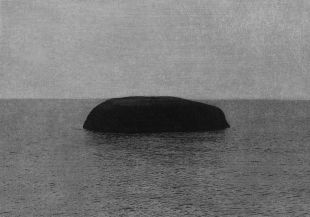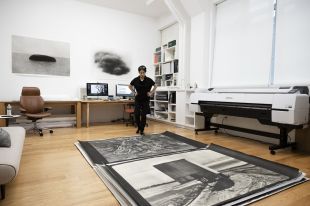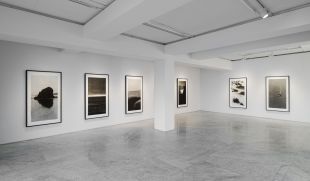 |
“Voice 01” (PKM Gallery and the artist) |
Upon entering photographer Lee Jung-jin’s solo exhibition, one may be overwhelmed by huge nature photographs in black and white. Then, upon bending over for a closer look, one might be tempted to touch them due to their unique velvet-like texture. This is because they are printed on Korean traditional mulberry paper, called “hanji.”
PKM Gallery in Samcheong-dong is hosting the exhibition, titled “Jungjin Lee: Voice,” two years after the artist’s solo exhibition at the Gwacheon branch of the National Museum of Modern and Contemporary Art. The current exhibition features 25 photographs from her previous series, “Opening,” and a new series, “Voice,” which incorporates digital printing techniques and is being shown to the public for the first time.
Lee took the photographs when she was traveling through the western part of the US, capturing nature scenes and trying to convey something significant about nature and her inner self. Although her photographs show concrete subjects from nature, her works are like poetry and her subjects seem to be metaphors.
 |
Lee: Lee Jung-jin works on her photographs. (PKM Gallery and the artist) |
“I want people to feel them. … They might approach you differently based on their own experiences,” she told The Korea Herald. “Instead of regarding them just as photographs, I hope the audience could take the moment of facing something deep inside their mind, something original.”
Lee is very careful when choosing words to explain her works. She worries that her explanations could “frame” her photographs, or limit what people feel upon seeing them. Her photographs are not even accompanied by captions or brief explanations. That is to allow the audience to freely react, with their own authentic thoughts and feelings.
At a press conference Jan. 13, she said her works are more about “feeling” than reading. Although she takes pictures at a static place, she has to press the shutter release quickly to capture the fleeting feeling or sensation she gets. She even waits until her subjects reveal their true nature, she said. She takes no more than 10 shots of each subject.
“The instant feeling is important, and I am not even curious about how the object was captured at the moment. I would get to see how the objects (turned out) while processing the work after I come back to the office.
“I do not even go back to the scene to take the same object to capture it again in the way that I expected (it to look),” she said at the press conference.
 |
Lee Jung-jin’s solo exhibition shows her 25 pieces of art. (PKM Gallery and the artist) |
Lee is the first photographer to succeed at printing photographs on hanji. She brushes a light-sensitive nitrate emulsion called “light liquid” on the hanji, which she buys in Korea. Her recent series, “Voice,” differs from her previous works in that she began using digital printing techniques so she would have more time to spend outside taking photographs.
“I pursued the analog style for so long when printing photographs, but I started to realize that it was too time consuming … for instance, if I took photos for two months, I had to spend almost a year in the darkroom for the printing process.
“I use hanji because it breathes, and it contains depth through the process of permeating the ink,” she told The Korea Herald.
Lee studied photography by herself beginning in her college years at Hongik University, although her major was ceramics. Upon graduation, she decided to pursue a photography career because she found that photography was the best way to express her artistic philosophy.
She later studied photography at New York University and became an assistant to Swiss photographer Robert Frank, one of the most influential photographers of the 20th century.
In 2011, Lee received international recognition when she took part in Frederic Brenner’s photographic project “Israel: This Place” together with several critically acclaimed photographers such as Stephen Shore, Thomas Struth and Josef Koudelka. That exhibition is traveling internationally to renowned institutions. She is currently based in New York.
Her solo exhibition runs through March 5 at PKM Gallery.
By Park Yuna (
yunapark@heraldcorp.com)










![[Today’s K-pop] Blackpink’s Jennie, Lisa invited to Coachella as solo acts](http://res.heraldm.com/phpwas/restmb_idxmake.php?idx=644&simg=/content/image/2024/11/21/20241121050099_0.jpg)